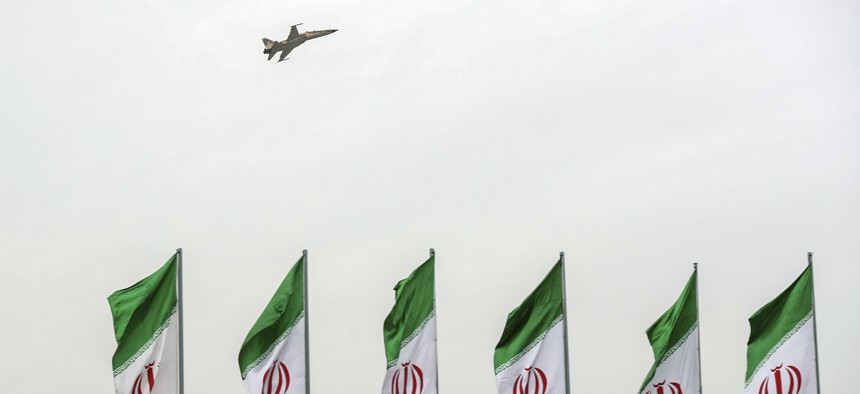
A fighter jet flies over Iranian flags during the army parade commemorating National Army Day in front of the shrine of the late revolutionary founder Ayatollah Khomeini, just outside Tehran, Iran, Thursday, April 18, 2019. Iranian Presidency Office via AP
A Bewildering Briefing on the Iranian Threat Leaves More Questions Than Answers
A deputy commander of the counter-ISIS coalition appeared to rebut White House claims about Iran-backed militias in Iraq and Syria.
This report has been updated to include a statement from U.S. Central Command.
“There’s been no increased threat from Iranian-backed forces in Iraq and Syria,” U.K. Maj. Gen. Chris Ghika said Tuesday in a rare on-the-record press briefing streamed from the Baghdad headquarters of the anti-ISIS coalition. “I’m not going to go into the detail of it, but there are a substantial number of militia groups in Iraq and Syria and we don’t see any increased threat from many of them at this stage.”
The remarks by Ghika, the coalition’s deputy commander for strategy and information, appeared to rebut Trump administration claims that Iran is “mobilizing proxy groups in Iraq and Syria to attack American forces,” as the New York Times put it. They also seemed to rule out one way Iran could be posing an “escalating” threat, as administration officials have claimed without detail for several weeks. And they did little to dispel simmering fears that National Security Adviser John Bolton is attempting to steer President Trump towards conflict with Tehran.
Last week, Bolton announced that the United States was hastening the deployment of an aircraft carrier toward the Middle East because he had reason to believe that Iran was planning some sort of attack on U.S. forces. Neither he nor other administration officials provided details, though they called the intelligence “credible.”
But in a confusing turn, Ghika on Tuesday denied that there was daylight between his assessment of the threat from Iran-backed militias and the Trump administration’s. Pressed to explain the apparent discrepancy, the U.K. two-star appeared to limit his earlier remarks solely to units of the so-called Popular Mobilization Forces in Iraq that the coalition considers to be “compliant.” The PMF, a collection of Iraqi state-sponsored militias, are mostly Shia Muslim groups, some of which are supported by Iran.
“There are a range of Iranian-backed forces. There are a range of groups in the PMF. It’s very difficult to start to delineate between them,” Ghika said. “But there are plenty of Iranian-backed forces in the PMF who do not present any threat to the coalition and we are monitoring the range of them very carefully.”
Further muddling the situation, officials with U.S. Central Command — which has responsibility for American forces the Middle East — moved Tuesday afternoon to contradict Ghika.
"Recent comments from OIR's Deputy Commander run counter to the identified credible threats available to intelligence from U.S. and allies regarding Iranian backed forces in the region," Navy Capt. Bill Urban said in a statement released on Tuesday afternoon. "U.S. Central Command, in coordination with Operation Inherent Resolve, has increased the force posture level for all service members assigned to OIR in Iraq and Syria. As a result, OIR is now at a high level of alert as we continue to closely monitor credible and possibly imminent threats to U.S. forces in Iraq."
Pentagon leaders were sufficiently concerned about the messaging that they included Urban's subsequent statement in the transcript of Ghika's press conference, an exceedingly rare move.
Ghika spoke just days after Acting Defense Secretary Patrick Shanahan presented a plan at the White House to send up to 120,000 troops to the Middle East if Iran attacks American forces or resumes work on nuclear weapons, unnamed administration officials told the New York Times. On Sunday, UAE officials said four commercial ships had been sabotaged just outside the Persian Gulf.
The rising tensions and uncertainty are rattling U.S. allies.
"We are very worried about the risk of a conflict happening by accident, with an escalation that is unintended really on either side but ends with some kind of conflict," British Foreign Secretary Jeremy Hunt told reporters in Brussels on Monday. "What we need is a period of calm to make sure that everyone understands what the other side is thinking."
But by Tuesday morning, there were some signals that neither President Trump nor Iran is actively seeking conflict. The president, who has long expressed ambivalence towards U.S. military engagements in the Middle East, on Monday night dismissed the Times’ report about sending troops to the Middle East. Added Iranian Supreme Leader Ayatollah Ali Khamenei on Tuesday: “there won’t be any war...We don't seek a war, and they don't either. They know it’s not in their interests."
Related: The Flash Point Between America and Iran Could Be Iraq’s Militias
Related: Trump’s ‘Maximum Pressure’ Won’t Make Iran Yield
Related: The US Escalates Even Further Against Iran—To What End?
Some analysts believe the current tensions will go no farther than saber-rattling.
“I don’t think Donald Trump is going to walk us into a war with Iran — and that gives the Iranians an opportunity to exert themselves in a measured way in the region and show that the U.S. is weak,” said Charles Lister, a senior fellow at the Middle East Institute.
Other analysts and lawmakers are less certain, pointing to Bolton’s track record on Iraq and the administration’s bellicose rhetoric. “Trump says he doesn't want war with Iran, but that's exactly what he wants, because that's exactly what Saudi Arabia, Netanyahu, al-Qaeda, Bolton, Haley, and other NeoCons/NeoLibs want,” tweeted Rep. Tulsi Gabbard, D-Hawaii, a 2020 candidate.
Ultimately, the bewildering briefing with the OIR officer raised more questions than it answered about the nature of the threat that sparked the deployment of the USS Abraham Lincoln, B-52 bombers, and a Patriot missile battery to the region.
Some Iraq watchers warn that officials in Iraq, Israel, and the United States are increasingly worried that Iran is covertly supplying long-range artillery rockets to proxy militias inside Iraq.
Others noted Ghika’s decision to include Syria in his original threat assessment, rather than focus on Iraq.
“I would be intrigued to see whether there was a Syria angle to this increased threat or not,” said Lister. “If we’re looking in the region where American troops are most vulnerable, it’s Syria, not Iraq.”
Asked if the coalition had raised the overall threat level in Baghdad, Ghika tersely demurred.
“If you walk into the base in Baghdad and you come here, then you can see the threat level,” he said.




